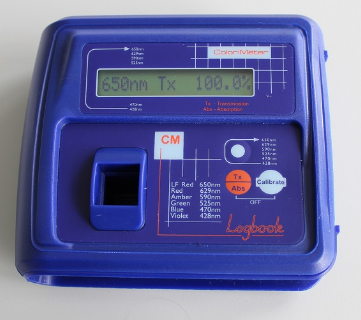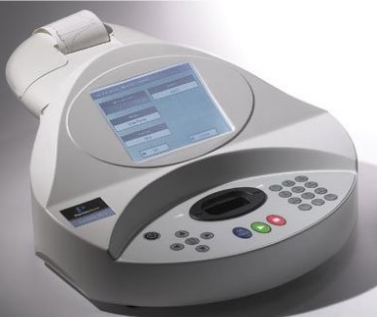What Is a Colorimeter?
A colorimeter is a light-sensitive instrument used for measuring the transmittance and absorbance of light passing through a liquid sample. The instrument measures the intensity or concentration of the color that develops upon introducing a specific reagent into a solution.
There are two types of colorimeters, color densitometers and color photometers. Color densitometers measure the density of primary colors whereas color photometer measures the color reflection and transmission.
How Colorimeter It Works
The sample is illuminated at about 45-degree angle by an internal light source. Light passes through the tristimulus filters (to get desired frequency), representing the amount of red, green and blue light reflected from the sample and concentrated using lens. The light transmits through the sample and the transmitted light is measured by detector. The measurements are then quantified into RGB values which simulate the way human eyes are sensitive to light.

Examples of colorimeter instruments include;
- HunterLab D25 series
- ColorTrend HT
Colorimeters are widely used to monitor the growth of a bacterial or yeast culture. They provide reliable and highly accurate results when used for assessment of color in bird plumage. They are also used to measure and monitor the color in various foods and beverages including vegetable products and sugar.
What You Need To Know About Colorimeter
- Colorimeter can be described as an instrument for psychophysical analysis, which measure human eye-brain perception.
- Colorimetric data directly read and provide tristimulus values such as XYZ, G, b, d etc.
- Colorimeter is generally rugged and less complex instrument than a spectrophotometer.
- Colorimeter is composed of sensor and simple data processor. It has only a set illuminant and observer combination.
- Colorimeter use fixed wavelengths in the visible range only.
- A colorimeter is generally used in production and inspection industries.
- Colorimeter measure the absorbance of light.
- Colorimeter isolates broad band of wavelengths using tristimulus absorption filters.
- Colorimeter quantifies color by measuring the three primary color components of light.
- Data is displayed on a digital or analogue output.
- Can be used to determine the concentration of an individual compound based on the amount of absorbance.
- It works well for routine comparisons of similar colors and adjustment of small color differences under constant conditions.
- Colorimeter is cheaper when compared to spectrophotometer.
- It is made up of stationary parts and it is lighter in weight and therefore good for field use.
- Examples of colorimeter instruments include HunterLab D25 series and ColorTrend HT
Spectrophotometer
Spectrophotometer is an analytical instrument used to quantitatively measure the transmission or reflection of visible light, UV light or infrared light. Spectrophotometers are widely used in various disciplines such as physics, molecular biology, chemistry and biochemistry.
There are two classes of spectrophotometers, they include single and dual beam. Single beam spectrophotometer measures absolute light intensity whereas double beam spectrophotometers measures the ratio of light intensities on two separate light paths-the reference standard and sample.
How Spectrophotometer Works
An electromagnetic energy collected from the sample, enters the device through the aperture (yellow line) and is separated into its component wavelengths by the holographic grafting which acts as a prism that separates the light into different wavelengths of the full color spectrum. As the grating rotates, the separated light is then focused onto a CDC array detector where the intensity of each wavelength (or each color if in the visible region) is then measured by a pixel of the array. The detector measures the sample’s light intensity, transmittance and absorbance and displays the output digitally in form of graph.

Examples of Spectrophotometer instruments include:
- HunterLab ColorFlexes
- COlorQuests
- LabScans
- MiniScans
- SpectraProbes
- UltraScans
What You Need To Know About Spectrophotometer
- Spectrophotometer can be described as an instrument for physical analysis which provides wavelength by wavelength spectral analysis of reflecting or transmitting properties of objects without interpretation by human eye.
- It can indirectly calculate psychophysical information.
- Spectrophotometer is generally a more complex instrument than a colorimeter.
- Spectrophotometer is composed of sensor, data processor and sometimes includes computer software. It has many available illuminant or observer combinations.
- Spectrophotometer uses a wide range of wavelengths in the ultraviolet, visible and infrared zones.
- A spectrophotometer is usually used in laboratories and research development applications.
- Spectrophotometer measures the amount of light that passes through a sample.
- Spectrophotometer isolates broad band of wavelengths using tristimulus absorption filter.
- Spectrophotometer measures the actual color within the human visible light wavelength.
- Data is produced and recorded via computer software.
- Can be used in identification and quantification studies of inorganic and organic biochemical molecules.
- It works well for color formulation, measurement of metamerism and variable illuminant/observer conditions.
- Spectrophotometer has a much wider range of functions, which includes functions of a colorimeter. Therefore it is more costly when compared to colorimeter.
- It is composed of moving parts and it is heavier in weight and only good for bench use.
- Examples of Spectrophotometer instruments include HunterLab ColorFlexes, COlorQuests, LabScans, MiniScans, SpectraProbes, UltraScans.
Also Read: Difference Between Rheometer And Viscometer
Difference Between Colorimeter And Spectrophotometer In Tabular Form
| BASIS OF COMPARISPON | COLORIMETER | SPECTROPHOTOMETER |
| Description | It is an instrument for psychophysical analysis, which measure human eye-brain perception. | It an instrument for physical analysis which provides wavelength by wavelength spectral analysis of reflecting or transmitting properties of objects without interpretation by human eye. |
| Capability | Colorimetric data directly read and provide tristimulus values such as XYZ, G, b, d etc. | It can indirectly calculate psychophysical information. |
| Complexity | It is generally rugged and less complex instrument than a spectrophotometer. | It is generally a more complex instrument than a colorimeter. |
| Components | It is composed of sensor and simple data processor. It has only a set illuminant and observer combination. | It is composed of sensor, data processor and sometimes includes computer software. It has many available illuminant or observer combinations. |
| Wavelength | It uses fixed wavelengths in the visible range only. | It uses a wide range of wavelengths in the ultraviolet, visible and infrared zones. |
| Usage | It is generally used in production and inspection industries. | It is usually used in laboratories and research development applications. |
| Main Function | Colorimeter measure the absorbance of light. | Spectrophotometer measures the amount of light that passes through a sample. |
| Isolation Of Broad Band | It isolates broad band of wavelengths using tristimulus absorption filters. | It isolates broad band of wavelengths using tristimulus absorption filter. |
| Functionality | It quantifies color by measuring the three primary color components of light. | It measures the actual color within the human visible light wavelength. |
| Data Display | Data is displayed on a digital or analogue output. | Data is produced and recorded via computer software. |
| Application | Can be used to determine the concentration of an individual compound based on the amount of absorbance. | Can be used in identification and quantification studies of inorganic and organic biochemical molecules. |
| Working | It works well for routine comparisons of similar colors and adjustment of small color differences under constant conditions. | It works well for color formulation, measurement of metamerism and variable illuminant/observer conditions. |
| Cost | It is cheaper when compared to spectrophotometer. | It is more costly when compared to colorimeter. |
| Nature | It is made up of stationary parts and it is lighter in weight and therefore good for field use. | It is composed of moving parts and it is heavier in weight and only good for bench use. |
| Examples | Examples of colorimeter instruments include HunterLab D25 series and ColorTrend HT | Examples of Spectrophotometer instruments include: HunterLab ColorFlexes COlorQuests LabScans MiniScans SpectraProbes UltraScans |